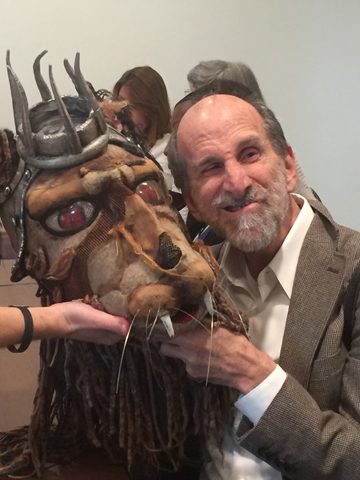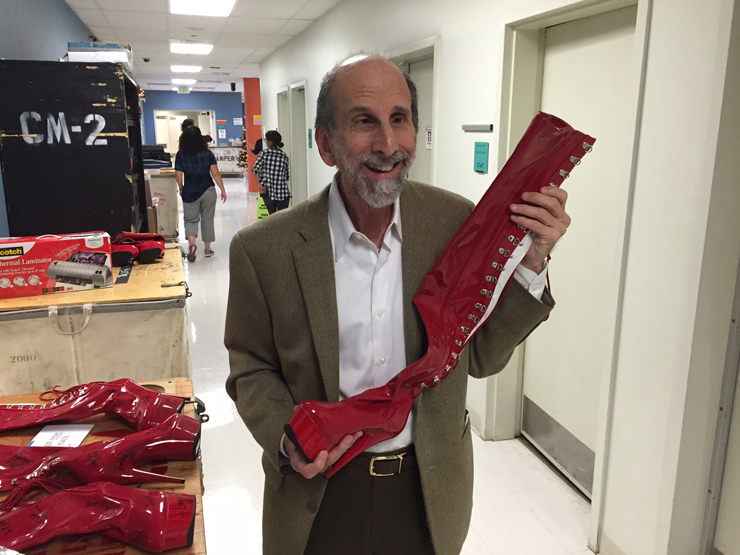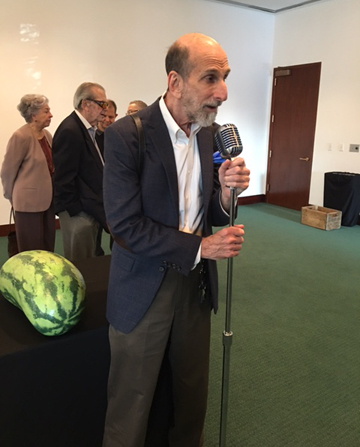
Steve Gladstone cheek to cheek with the Mouse King.
If you attend a play and close your eyes for two hours (absurd, I know, but stay with me on this) and just listen to the dialogue, you’re gonna miss some important stuff. You may follow the fate of the principal characters, but you won’t know much about the costumes, lighting, details of the set (or when the set changes locales) and what is happening on stage when nobody is speaking.
Of course, most people who attend the theater can see the facial expressions of the characters, the scenes changing and the exploits that are happening when the players aren't speaking. Blind folks don't have that option and consequently miss much of the action and information dynamic to the story. The Arsht Center set out to remedy that significant issue back in 2010 with their "audio description" program for their sightless patrons, describing the many elements essential for a blind person to get a complete picture of what’s happening on stage during the Broadway in Miami series, Florida Grand Opera and Miami City Ballet productions.
Now blind and visually impaired peeps get a better picture knowing that Baby wore a “bright pink halter top dress for the exhibition dance at the Sheldrake Hotel and a pink dress with low back, thin shoulder straps and very full skirts in the last dance of the season at Kellerman’s.”
The recent Arsht production of the musical, “Dirty Dancing,” based on the 1987 hit film, was loaded with 1963 period costumes, flashing lights and projected backgrounds ranging from mountains to a golf course, log cabins, a lake, woods and camp fire. At the top of show, two panels on each side of the stage projected outdoor scenery of “green trees and blue sky with fluffy white clouds." All those colorful images would be lost to blind folks without the crackerjack volunteer readers sitting in a booth inside the Arsht's Ziff Ballet Opera House, describing the sets, lighting and costumes to their blind guests.

Steve with kinky boot before the show "Kinky Boots."
Over a dozen years ago, the original Broadway production of “Wicked” was experimenting with pre-recorded narration tied to the musical score. It had inherent technical problems and was often out of sync as every show was, of course, a little different from performance to performance. The Arsht team fixed that challenge by describing the shows in “real time,” the describer calling each scene as it unfolded. The blind patron wears a pair of headphones attached to a receiver while the narration is transmitted via an infrared signal to the assistive listening device, which can be enjoyed from any seat in the house.
Blind theater-goers found out that Baby was “slender, medium-height with short curly hair, wearing denim Bermuda shorts and a casual white blouse, and Johnny was medium tall with a slender but, well-muscled build and neck length light brown hair with gold streaks, wearing snug black pants with a black sleeveless tank shirt.”
“Penny, the girl who gets pregnant, tall and slender with a lovely figure and bleached blonde below the shoulder hair; Mr. Schumacher, an elderly resort guest who steals wallets, balding and rotund; the young men on the entertainment staff wearing a t-shirt with the resort name, Kellerman’s…” – all described so you get the bigger picture.
If you're blind as the curtain goes up, all you hear is the song, “This Magic Moment” but, with those dimension-adding headphones, you find out that a couple is dancing, the woman arching her back as the man lifts her up, while Baby, in her bedroom with an open suitcase packed with clothing, writes some notes in a book she is reading, the scene quickly changing to Kellerman’s Resort in the Catskills. There’s a whole lot more going on than just a rockin’ tune!
Many scenes were underscored by music without any dialogue. Without the vivid audio description, blind folks would not know who was entering and exiting, when someone was shimmying, when a skirt bellowed, when strobe lights washed over the audience, when a sunset boasted pinks, blues and purples, when Johnny changed into his tux, when evening came and chandeliers descended from above, when Penny wrapped her legs around Johnny’s hips and the male dancers flipped and spun during the afterhours dance at staff headquarters.
How else would sightless folks know that Baby was awkward when first learning the mambo routine with Johnny? Or the point at which they were swinging their hips perfectly together? Or Johnny teaching her how to improve her balance by practicing on a log? Learning the famous lift in a lake? Or that she stopped short of making her final leap into Johnny’s arms during the show at the Sheldrake?
Baby’s memorable line, “Most of all I’m afraid of walking out of this room and never feeling the rest of my whole life the way I feel when I’m with you,” was certainly enhanced by knowing that her eyes were locked with Johnny’s as he pulled her closer, slowly carrying her to his mattress, as the first act ended.

Steve Gladstone
The theme song, "(I’ve Had) The Time of My Life" "saw" Baby and Johnny in sync, Baby springing toward Johnny, her arms outstretched, making that final, famous leap where previously she had hesitated.
In this summer of 1963, before The Beatles arrived, before the death of John Kennedy, while the civil rights movement was heating up, this coming of age love story unfolded, seemingly less profound than the current events of the day, yet touching a significant romantic nerve – and now creating a more three-dimensional picture for blind folks.
Blind peeps were certainly not put "in a corner!"
To further the experience, visiting companies are asked to do a "touch tour" of props and costumes prior to the audio described performance. Blind guests can go cheek to cheek with the Mouse King, sample a thigh high kinky boot or grip the old school mic used at Kellerman’s Resort.
Over 60 performances at the Arsht have been audio described to date, including "The Lion King," "Wicked," "Jersey Boys," "Madama Butterfly," "The Magic Flute," "Carmen" and "The Nutcracker."
In 2014, the Arsht Center was honored with the Dolly Gamble Award from the Florida Council of the Blind for its leadership in audio description and received the national award from the American Council of the Blind for excellence in audio description in the performing arts category.
Audio description may be provided for any performance as the Arsht team has the equipment to make it happen in the Ziff Ballet Opera House, Knight Concert Hall and Carnival Studio Theater.
Interested in upcoming audio described programs? Information is available on the Arsht Center website at www.arshtcenter.org, write Alice at afifelski@arshtcenter.org, or call the office at 786-468-2294, cell 305-785-3899.
 MAIN MENU
MAIN MENU

